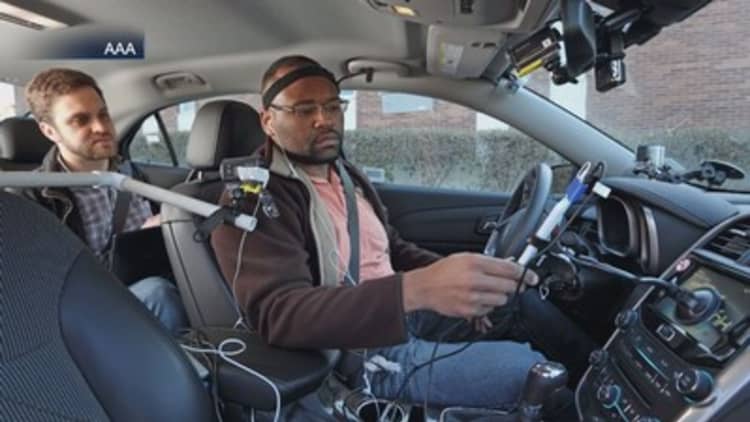
With 40,200 deaths, 2016 was the deadliest year on the road in a decade. While drunk driving and higher speed limits are factors, distractions are increasing the danger as well.
In 2011, 52 percent of drivers reported owning a smartphone, and by 2014 that number soared to 80 percent. It's no surprise, then, that using a phone while driving is distracting. However, what many people may not realize is how long the distraction lasts.
In a study conducted by AAA Foundation for Traffic & Safety, researchers found that drivers can experience a "hangover effect" where the mind stays distracted for up to 27 seconds after using voice-to-text features. These include actions like sending text messages, making phone calls or updating social media.
That means even if drivers perform some of these tasks while parked, or stopped at a red light, "Once you start moving, even after you stop using [the technology], your mind is still not on the task," Robert Sinclair, spokesperson for AAA-New York, told CNBC's "On the Money" in an interview.
"The level of distraction gets so bad that a person gets in a zone where its 'inattention blindness' … where you're looking at the road but you're not seeing what's in front of you. We're talking about pedestrians, cyclists, other cars, red lights, stop signs, those sorts of things," he added.
"There's no technology, that we're aware of right now, that would enable you to do these functions while you're driving safely."
One company, San Francisco start-up Navdy, intends to lessen the danger behind the wheel with its heads up display technology. It puts the information that's on your phone—whether its navigation, emails, or text messages—on a small screen in front of the driver.
While it's still distracting, founder Doug Simpson says it's better than the driver taking their eyes off the road.
"People are going to make phone calls, they are going to use turn by turn navigation, they are going to listen to music. This is a far safer way to do these things in the car than the alternative," Simpson told CNBC.
Yet Sinclair said the AAA has been advising technology and vehicle manufacturers that "they need to have some sort of system in the vehicle that will shut these systems off while the vehicle is in motion."
According to Sinclair, the auto manufacturers responded to AAA's warnings by saying their voice activated technologies help mitigate the danger.
However. not all voice activated technology is created equal.
AAA conducted a study testing the distraction levels of ten 2015 car voice-activated systems, assigning a figure based on how distracting the technology is. AAA considers a mental distraction of 2 or higher to be potentially dangerous while driving.
It found that the 2015 Chevy Equinox and Buick Lacrosse hands-free technology had a mild level of distraction, while the Mazda 6 had the worst.
Currently, 14 states and D.C. prohibit drivers from talking on a hand-held cell phone, while and 46 states and D.C. prohibit text messaging while driving.
But why isn't there more regulation when it comes to voice activated technology and car infotainment systems?
"The government can't possibly keep up with the advance of technology, it just moves too quickly," Sinclair said, adding it's ultimately up to the consumer.
"We hope the information that we have, these studies, that show that it's dangerous no matter what, will keep people from doing them while they are driving."
On the Money airs on CNBC Saturdays at 5:30 am ET, or check listings for air times in local markets.



